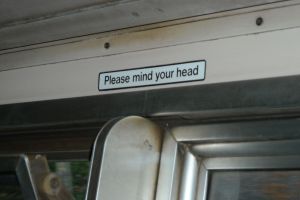Co-Written with Marisol Brito. Originally posted at the University of Minnesota’s Techniques in Teaching and Learning blog.
Learning from Early Childhood Educational Practices
My son has just turned three and, as a self-proclaimed pedagogy nerd it is not surprising that I currently geek-out by reading up on Magda Gerber or the Reggio Emilia approach to childhood education or checking out similarly-minded counterparts in the blogosphere.
While reading a recent post by preschool blogger extraordinaire TeacherTom – who advocates for alternative, engaging educational practices that emphasize his status as a co-equal with his students – I was struck by parallels between his pedagogy and the kinds of things I teach my University-level ethics students about how human beings ought to be treated.
 Although I originally came to these resources as a parent, I have been thinking about how deeply ideas from early childhood education have resonated with me as a teacher in Higher Education. These ideas include:
Although I originally came to these resources as a parent, I have been thinking about how deeply ideas from early childhood education have resonated with me as a teacher in Higher Education. These ideas include:
- valuing young people as equals regardless of age or experience,
- helping young people acquire an internal sense of accomplishment as opposed to responding to extrinsic rewards, and
- caring for young people as whole persons.
Recently, I began to wonder if Teacher Tom and other early childhood educators could help me create a classroom that was more true to the values I encourage my students to take seriously. I began reading his posts and other early-childhood material with a new eye and began asking myself:
What can higher education learn from early childhood educational practices?
Asking Everyone
Actually, I began asking everyone – including fellow pedagogy nerd and this post’s co-author, Alex Fink, who, as is his usual style, adopted the question and ran with it. Soon, we were full of questions:
- As we teach, do our teaching practices reflect the values we espouse – as educators? as institutions?
- If so, what are those teaching practices?
- If not, could early childhood education help us to accomplish this goal?
- What would adopting early childhood educational practices look like in a college or university classroom?
- Are we, as educators in higher education, missing an important and valuable resource by overlooking early childhood educational research?
Alex and I decided to choose practices from early childhood education that we felt might be unknown in higher education and to begin to imagine how we could translate these practices into our own teaching in college and university classrooms. Our interest in doing so came from two commitments:
First, that our teaching practices be consistent with our philosophical beliefs.
Second, that our teaching practices align with our social values of democracy and human equality.
We would like to invite you into this discussion as well. Below are three practices that we found particularly intriguing – and some early thoughts on how they might, and if they ought, appear in higher education.
“Loving them Just as They Are”- Treating Students as Human Equals
It may seem strange, I suppose, for many of us to understand that we, at best, stand on the planet as equals with all other people, including young children. We are each fully formed, fully valid, fully functional human beings no matter our age. Naturally, we have different lots in life, different blessings and challenges, and are on our way to different places, but we always remain, most of all, worthy of being loved for being exactly who we are. TeacherTom, LovingthemJustasTheyAre
If a preschool teacher can look to a group of four and five year-old children as equals, and can take pains to treat them as such – what might that tell us about our relationship with the young adults (and not-so-young adults) we find in our classrooms? Are there ways that we can present ourselves or organize our classrooms and materials that would better recognize our students as our human equals? What would this recognition look like and sound like in higher education classrooms?
We are concerned that some things accepted as standard practice in university teaching might make it difficult for instructors and students to experience one another as human equals. For example, the standard lecture model holds that teachers have information, and students receive it – the transfer of information and ideas is a one-way street. Likewise, classes and syllabi are often planned far in advance, minimizing the space for students to influence the direction of the course with their knowledge, experience, and interests. It is almost as if we make a deal with students: we will give you information if you leave your self, who you are and what you otherwise care about, at the door.
 In response to these problems, we have tried to modify our own practices – and believe there is room to continue to do so. For example, we try to limit lecture time in order to focus in class also on practicing critical thinking skills that offer students ways of learning to engage with the material independently. We also give them ample class time to practice these skills and invite them to conjoin their real-life experiences with the material at hand. Additionally, we try to create an environment where students care about practicing, feel supported in practicing, and are challenged to practice these skills. In some ways, this feels more like coaching than teaching – coaching is not built solely on a history of being a superior player, but rather on using that experience to develop structure and provide resources for other players to improve their skills.
In response to these problems, we have tried to modify our own practices – and believe there is room to continue to do so. For example, we try to limit lecture time in order to focus in class also on practicing critical thinking skills that offer students ways of learning to engage with the material independently. We also give them ample class time to practice these skills and invite them to conjoin their real-life experiences with the material at hand. Additionally, we try to create an environment where students care about practicing, feel supported in practicing, and are challenged to practice these skills. In some ways, this feels more like coaching than teaching – coaching is not built solely on a history of being a superior player, but rather on using that experience to develop structure and provide resources for other players to improve their skills.
We know that efforts like these take a lot of work and encouragement – for ourselves and for our students – and willingness to break down barriers, especially the societal training we all receive to see teachers as authority figures and students as those learning from the authority. But we also know that with college students, as with children, learning is about breaking barriers to come to new understandings, insights and discoveries.
Given the myriad challenges, what are other ways we could change our classrooms to better achieve our goal of holding students as human equals?
Praise v. Encouragement – Moving Beyond ‘Good’ and ‘Right’
Following the Praise v. Encouragement model used by the Montessori approach to early childhood education, my (Marisol) son’s teachers avoid evaluative statements and instead strive to use observation to engage with children about their work and to encourage them to be process rather than product minded. For example, rather than using praising language such as “What a beautiful drawing!” a teacher might observe, “I see you used three colors in your picture. Your lines go from the bottom of the page to the top, and some curl in a lot of different directions.”
Language of praise (e.g. great, beautiful, good job, etc.) focuses on an end product, and sets up external standards of success and failure.
Language of encouragement focuses on acknowledging the creative or learning process, and reflecting back to the student what she or he has done.
For example, if a students adopts the notion, from experience of praise, that a picture only has value because it is beautiful (0r a student has value because she can create a beautiful picture), then it ay become difficult for the student to engage in an activity when he or she does not feel confident. The experiential process of drawing a picture becomes – with the language of praise – a chance for success or failure based on perceptions of the end project.

How many of us struggle with students who take a class, write a paper or complete an assignment “to get an A” rather than valuing the content or learning process? Does this model of product-focused work hurt the learning process or, put conversely, help our classrooms in any way? What would a process-focused classroom look like? Sound like?
It has been difficult to wean myself from scrawling “good” or “great” down the margins of student papers. I still remember clearly how much I valued and felt validated by such comments from professors I admired. However, I am trying to move towards language both on papers and in the classroom that recognizes and reflects student process. Rather than saying “good” when a student makes a remark I find insightful, I might repeat what I understood the student to be saying, “Ah – So I hear you saying that because the second story gives us more information about Rosa Parks background and intentions, it more accurately portrays her as a rational agent.”
Along the same vein, if a student makes a comment I don’t understand, or disagree with, I will again try to rephrase what they are saying as I understand it, and if they agree with my interpretation, I will then give reasons (or allow other students to give reasons) as to why we may disagree or not follow the students thoughts. This allows us to engage in honest conversation without limiting the discussion to a particular set of right or wrong, good or bad answers.
We see using encouragement as one way of supporting what Carol Dweck calls a “growth” rather than a “fixed” mindset in students. However, we see a lot of challenges to this method. To begin, are students’ expectations of “praise” already so deeply embedded in their experience of school that to offer anything different is simply interpreted as a failure to completely succeed? Does the phrase “I see that thought connecting to this one” offer something less by way of encouraging further thoughts than “Great idea! Let’s connect that to…”?
Our hope is to find language that provokes students to take the risk to do something new, to explore new possibilities, to grow their thinking in order to grapple with course and work and life problems that require complex rather than right-wrong thinking.
Is this a productive change? How could we improve on it? Are their other (perhaps larger, more systemic) changes that we might want to consider? For example, can we shift away from the praise model without also moving away from traditional grading systems?
Care – Students (Re-)Engage the Classroom
My son runs into his classroom and throws his arms around a favorite teacher. Another teacher is holding a child who softly cries for her mother. I watch a child crawl into a teacher’s lap for story time. Whether they are tired, hurt, scared, lonely, excited, proud or unfocused, the children know that the teachers are there to hold those feelings with them – to literally physically hold them until they are ready to re-engage independently with the classroom or playground.
In a college or university setting, discussion of such physical affection would immediately draw red flags. But, are there appropriate ways for us to – metaphorically – hold our students? Surely our students are not immune to being tired, hurt, excited and proud – and what’s more, often they are far from home. When they need it, how can we help our students regroup and be ready to engage or re-engage with their academic work? Further, should we? Is this the work of other on-campus organizations or staff?
Many of our students are used to seeing friends, family, and teachers on a regular basis. Transitioning to a college campus, they lose many of these social supports. Often times, as their teachers, we end up seeing them on a more regular basis than most other people in their lives. We also see their projects, presentations, papers and tests, and know when they are slipping. Though we may not be their counselors, we can take some responsibility for the connections we do have with our students, and might be able to find obvious, or even creative, ways to support them. Further, we might find ways to help them support each other; to create a space in our classrooms where students can offer one another support and connection.
One teacher I (Alex) admire never actually physically holds students. He does, however, attend to their deeper psychological needs. If they are in need of an ear, he will sit with them and listen. If they are in need of a job, he’ll help them find one. If they are quickly slipping out of school, he will appoint them as an undergraduate TA and keep an eye on them throughout the semester. He will also do a great deal of work throughout the semester to connect them to each other – if students seem to have common interests, he will make sure they meet. If one student is struggling, he will see if another can help. These all seem like appropriate ways teachers can “hold” their students. Are there others? Can (and ought) we go further?
Conclusions
In this post, we’ve suggested thinking about ways we can better treat students as human equals, move students beyond extrinsic reward and toward an internal sense of success, and care about students as whole persons. Each of these ideas was drawn from, and is supported by research in early childhood education. We believe that these methods help us match our approach to teaching in higher education with the values we hold, and that the research shows these may also be more effective approaches to teaching generally (Svinicki, 2010; Dweck, 2008; Duncan-Andrade, 2010).
As pedagogy nerds we value these discussions and we welcome your thoughts:
What approaches from early childhood education can help us see teaching and learning in new ways? Which of these approaches can be adapted to higher education appropriately?
Resources
- Magda Gerber – http://www.magdagerber.org
- MN Reggio Emilia Network – http://www.mnreggio.org/
- Teacher Tom – http://teachertomsblog.blogspot.com/
- Janet Lansbury – http://www.janetlansbury.com/
- Svinicki, M. & McKeachie, W.J. (2010). McKeachie’s teaching tips: strategies, research, and theory for college and university teachers. Belmont, CA: Wadsworth, Cengage Learning.
- Dweck, C.S. (2008). Mindset: The new psychology of success. New York, NY: Ballantine Books.
- Duncan-Andrade, J.M.R. (2010). What a coach can teach a teacher: Lessons urban schools can learn from a successful sports program. New York, NY: Peter Lang.
- Praise vs. Encouragement, a table of distinctions:http://virtual.mjc.edu/prussol/Praisevs.pdf